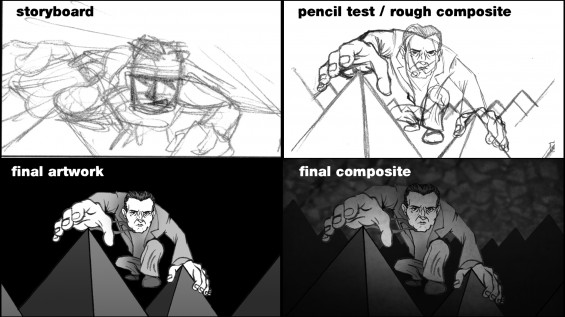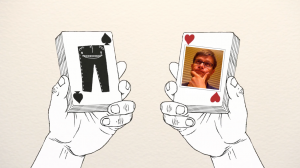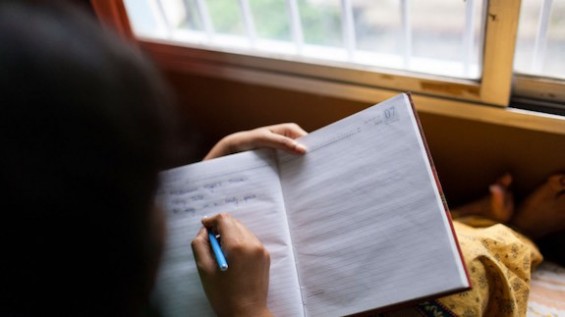
How do you animate a thing like cosmic rays? The story behind a TEDxCERN TED-Ed lesson
Cosmic rays. Active galactic nuclei. Nucleosynthesis. For physicist Veronica Bindi, this is the vocabulary of the everyday. A ten-year collaborator with AMS-02 — an experiment analyzing the data coming in from the Alpha Magnetic Spectrometer, a particle detector mounted on the International Space Station — Bindi deals with dark matter, solar activity, and the ins-and-outs of flight particle detectors with ease. But for someone without a double-digit career in particle physics, these topics can seem intimidating.
Bindi believes they shouldn’t be. Which is why when she was asked if she would contribute to a series of short physics-related lessons created by TED-ED for TEDxCERN (the upcoming TEDx event at the famed particle physics lab), she was both ecstatic and a bit daunted by the prospect. How would she make things like cosmic ray detection, collapsing stars, supernovae, black holes, and a years-long dissection of the building blocks of our universe come alive — in a video that clocks in at about four and a half minutes?
But she was up for the challenge. She already knew about TED-Ed’s library of original animated lessons, having used other CERN-written lessons to get high school students excited about STEM. (Her favorite is “The beginning of the universe, for beginners” by CERN physicist Tom Whyntie.)
“Sometimes I’d dream about what I would do if I could have the opportunity to develop my own animation,” she wrote to TEDx. “So you can imagine my surprise when I received an email from the head of TEDxCERN, Claudia Marcelloni, asking if I was interested in making a proposal for an animation.”
Bindi’s proposal? A primer on cosmic rays — those intriguing particles from outer space that help scientists understand space itself. But after the excitement came the questions: How do you transform a complex scientific concept into an easily-digestible lesson? How do you make astroparticle physics palpable and palatable?
Bindi was not alone in tackling these questions. She took on the script, while a team at TED-Ed — including lesson director and veteran animator Jeremiah Dickey — handled the animation. As a non-physicist, Dickey had his own challenges to face; mostly, translating the language of another field into that of his own, or — in other words — transforming science into art.
To figure out just how this happened, we spoke with both Bindi and Dickey via email. An edited version of the conversations follows:
Veronica, have you ever done something like this before? What was it like working with an animator?
VB: This is my first animation. I thought many times about developing animations. My field of specialization is astroparticles, and more than general physics, it is not easily understandable to people not involved with it. That’s a pity. I believe that animations are a key pathway to draw people’s interest to a new topic. Animations reach where words fail; they allow people to easily understand concepts that would be so complex to understand otherwise. I really liked to work with an animation team such as TED-Ed. I appreciated the opportunity to see the many and tiny details they take care of and all the steps and the many different people involved that lead to the final product. It was really fun.
How involved were you in developing ideas for the animation?
VB: My task was the script, so I wrote the text for the animation, but the idea of making an animation was so fun that I ended up imagining and then proposing concepts for the animation. Mine was just a proposal, an idea, but because of that I really visualized it frame after frame in my mind. I pictured it. I also enjoyed rewriting and improving my imaginary animation.
When the TED-Ed team contacted me to show me the first draft of the animation, I was extremely excited, but also very scared at the same time. It was time to face the music. A shock! Of course, the animation was completely different from the one I had in mind: It was not so “Star Wars,” as I expected, but it was much more fluid, more “universal,” and the message was really powerful and impactful. It was really fascinating to see my story through the eyes of somebody else. It is amazing how everything changes when looking at it from different perspectives. I really enjoyed then to help in the details of the real animation, to make it more effective.
Was it difficult to turn a scientific concept into a short lesson?
VB: I’ve done my best. I can assure you it was not such an easy task. You need to summarize so many concepts in a short message. “Where to start? What to say? When to conclude?” … all in just a few minutes. Your mind starts to spin around producing ideas, adding concepts, then deleting them, getting excited and then completely frustrated. “Impossibile!,” I said to myself in Italian. “I can’t! I can’t just summarize all that in a few concepts.” But then after a lot of re-wording and rewriting, the animation takes its shape, word after word, the script is complete and you really just love it.
What was the most interesting or exciting part of the project for you? What was it like to see the final product?
VB: The most exciting part was just to be part of it. The day before you just dream about making an animation, and the next day you are working with a team of professional animators known in all the world. Is it not fantastic? Now I get goosebumps. When I saw the final product, I was proud of our work!
Jeremiah, how do you go about turning a complex scientific concept into an animation? What is your process? Do you have a clear idea of what you want to do at the start, or does it morph as you go on?
JD: It’s rare that I have a completely clear idea at the start, but I do try to choose lessons to work on that spark some visual ideas at first. Invariably, the next step is then improving my own understanding of the subject, which is often fuzzy at best. I start by printing out the lesson with a lot of space between the lines so I can doodle on the page as I read it over and over. These doodles are usually worthless, but they’re a starting point — they make obvious the areas of the lesson I need to focus on. Research to bridge those gaps, lots of re-reading and more sketching eventually will lead to a cohesive plan that, hopefully, flows well and communicates the material in a compelling way. So in a way, figuring out how to visualize the material sort of parallels my own path from ignorance to understanding it, hopefully without mixing too many metaphors along the way.
What did you draw inspiration from while planning out the visuals?
JD: I’m really fond of mid-20th century “space age” art, a lot of which was really kind of propaganda for the Cold War space race between the U.S. and the U.S.S.R. There’s a lot of great art that came out of that — on both sides — that is always a pleasure to delve into. I looked at the paintings of Robert McCall, who did a lot of fantastic concept art for NASA from the Apollo era onwards. There are also a couple of animated Disney films dealing with the science of space directed by Ward Kimball in the mid-1950s that always inspire. Not sure if I can say how any of these things directly influenced the animation, but they definitely informed it.
What was it like working with a scientist from CERN? Do you often work on science-related lessons?
JD: It’s really an honor to get to work with people who are on the cutting edge of scientific discovery — and, to be honest, a little intimidating to be tasked with visualizing their lessons, as it’s likely how many are being introduced to the concepts they are studying at CERN. But Veronica’s lesson on cosmic rays does a great job presenting the material in a very clear way that really is the essence of good teaching — making the complicated understandable, and in this case, doing it in an appropriately mind-blowing context.
You can watch the entirety of their creation below or on the TED-Ed website:
Tune in to TEDxCERN tomorrow, September 24, for more insight into our universe and a look at what progress in science means for our future. You can watch the whole event — for free — from 7:30 am to 7:30 p.m. (EST) on their website.




Great TED-Ed video and post!
I think the collaboration between an animator and an educator is not easy because they might have different visions of the same idea. The result is awesome, and sharing how you got there is great. Thank you!